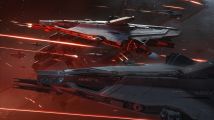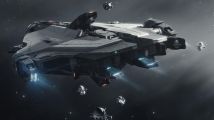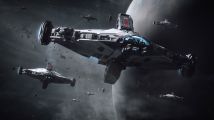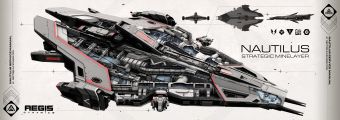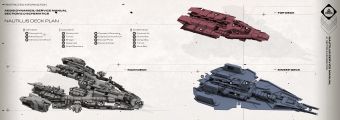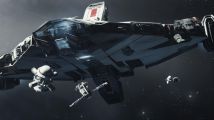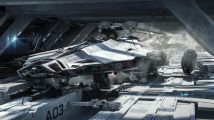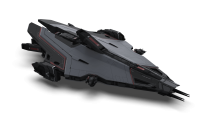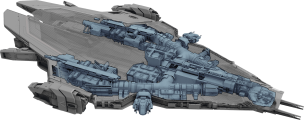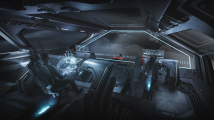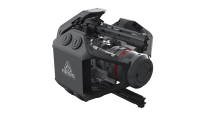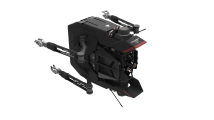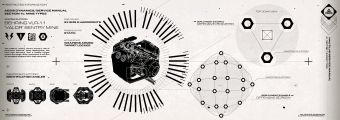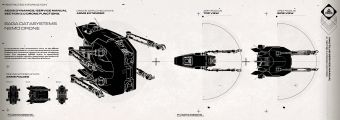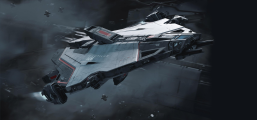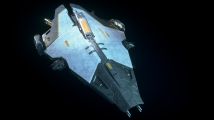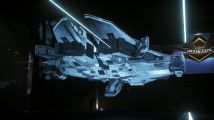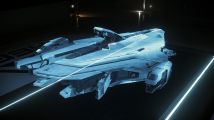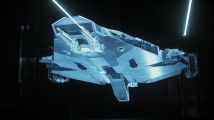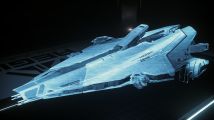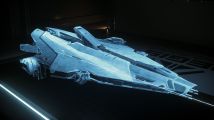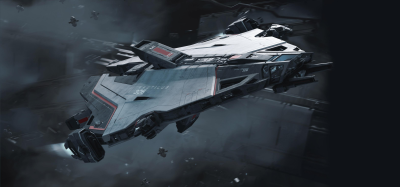 | |
| Gyártás állapota | |
|---|---|
| Nautilus | |
| Gyártó | Aegis Dynamics (AEGS) |
| Szerepkör | Minelayer |
| Hangar típusa | Large (S5) |
| Helyettesítő jármű | Hammerhead, Avenger Titan |
| Általános adatok | |
| Legénység | 4 – 8 |
| Raktér | 64 SCU |
| Költségek | |
Vételár
Nem elérhető
Bérlés
Nem elérhető
Standalone
$725
S. orig.
$725
Warbond
$675
W. orig.
$675
Elérhetőség
Time-limited sales
Igénylés
Not available
Bérlés
Nem elérhető
| |
| Specifikációk | |
| Hosszúság | 125 m |
| Szélesség | 72 m |
| Magasság | 21.6 m |
| Tömeg | 13,526,320 kg |
| Lore | |
| Bevezetés | 2549 CE |
The Aegis Nautilus is a large military minelayer ship, with fully-integrated mine-deployment, sweeping and disarming capabilities. Originally introduced in 2549, the ship has had centuries of refinement until reintroduced in 2949 for its 400th anniversary.[1]
Brochure description
Although not classically desirable like some of Aegis' most famous ex-military craft and initially considered a niche necessity of distant outposts, the serious firepower and long-range capability made it a surprise hit.
Specifications
Features
- Mine Control Room: A fully-developed control room for the queuing and deployment of the Nautilus' payload.
- Crew Comfort: A mess hall, crew quarters, and captain's quarters are designed for long-term comfort on deep-space missions and operations.
- Defensive Turrets: three manned turrets with 2x S3 guns each, and a front-mounted manned turret with S7 guns keeps the Nautilus protected in the hottest of deployment or disarming zones.[1]
Deployables
| Image | Type | Description |
|---|---|---|
| Homing Mine | The Firestorm Kinetics Tephra Homing Mine is a mine that once within range, will move towards the target and detonate. Its primary role is to establish a defensive perimeter. This mine has the same destructive power as a size 5 torpedo. | |
 |
NEMO Drone | The Saga Datasystems NEMO Drone (Neutralize and Employ Mine Ordnance) is a drone specifically designed for the task of identifying, deactivating and collecting deployed mines. In accordance with amendment 17c1 of the Militia Mobilization Initiative, a mine retrieval device must be present and functional aboard all armed minelaying craft. |
 |
Sentry Mine | The Behring VLR-11 Sentry Mine is a mine fitted with weapons that will fire on hostile targets when within range. Its primary role is perimeter defense. The sentry can house 2x size 2 guns. |
History
The Nautilus was introduced in 2549, at a time when tensions between the UEE and the recently discovered Xi'an empire had increased. Before that time, space mines were slowly coming to prominence as an effective form of defense. Particularly during the First Tevarin War, where combat engineers utilized repurposed freighters and troop transporters to deploy improvised proximity mines. Taking this as inspiration, initial concepts of the ship featured expansive holds for large volumes of explosive distribution. However, feedback from the crew themselves led Aegis to focus on precision over volume instead.
After its debut, in the midst of the Human-Xi'an conflict, the ship was utilized in countless successful missions along the Perry Line between 2550 and 2793. Despite this, the Nautilus ships were far from refined. Aegis would remedy that over the following generations. One such improvement was the addition of a conveyor belt in 2555. This would move mines into place for deployment. Previously this would have been done with a trolley system, and proved too slow and cumbersome. But even the belts had its problems, as they would often jam. In 2601 this was replaced with an overhead rail system. This system proved itself very useful in Operation Blindside by the naval ship Peace. This operation is noted for the heavy mining of the Tohil asteroid belt that resulted in the accidental elimination of the violent pirate crew the Big Hats.
Later revisions saw the addition of a sentry mine, which proved successful in being a more sustainable and less destructive counterpart to the proximity mines. Even the onboard facilities evolved much over time. Original Nautilus models had a lower payload capacity, because they were mostly designed for short runs. As technology advanced, and crews became more precise and strategic, the need to return home to rearm was decreased. The quarters and facilities were soon expanded for much longer tours.
During the Second Tevarin War, the Nautilus was given its first real test in open warfare. The ship was originally designed to deter traditional battles rather than to participate in them. The extreme aggression of the Tevarin forced Aegis to adapt and refine their proximity mines. Homing functionality saw its first iterations, and proved useful and enduring. In spite of (and thanks to) a handful of missteps (like a backfiring mine during the battle of Voska), this period provided an unprecedented opportunity to refine form and function of the Nautilus.
"As our situation changes, we must adapt in order to effectively address the shifting priorities, strategies, and ferocity of our enemies, whoever they may be. As we strive to adapt designs to suit these ends, we hope to use the combined knowledge of past contention to continue refining the Nautilus, its systems, and its capabilities, with the ultimate goal of creating a package versatile enough to effortlessly adapt on the fly to any conceivable threat or situation."
Mila Aukerman, Lead Development Engineer[1]
The Battle of Centauri also featured a primary role for the Nautilus, although often not covered in schooling. In the time preceding the famous battle, valuable intel was intercepted detailing the enemy's attack plans, and a sapper squadron named the Blackhearts, used this intel to lay fields of proximity charges at key entry points around the system. They intentionally left subtle routes through this 'maze' that allowed UEE interdiction units to lure the enemy into the minefield. This destruction caused a large portion of the enemy forces to not reach the battle and ultimately lead to the UEE's victory.
Even since the fateful Vega conflict with the Vanduul in 2945, the Nautilus played a crucial role in many battles in the ongoing Vanduul War, even though much of the sapper crews came and went unnoticed. One such example is the mission known as the Hellkite Run. Its purpose was to cut off Vanduul escape routes out of Oberon. An entire Vanduul squadron was eliminated trying leave the system to refuel and rearm. To this day, Nautilus sapper crews continue to maintain defense of the Oberon system, amongst others.
When the UEE announced their Militia Mobilization Initiative in 2946, Aegis started declassifying and marketing the ship to the general public. Due to several incidents involving private ships being damaged and lost when visiting systems previously touched by war, one amendment to the initiative stipulates that all currently in-production ships with minelaying functionality must be equipped with the means to disarm and/or remove their payloads. One example of such an incident is the loss of astronomer Katherine Ellen and her crew. their ship was destroyed during a live broadcast detailing the dangers of travel routes through the Hadrian system, caused by a disturbed mine. After the amendment, previously dangerous locations can be more easily cleared of residual ordnance. The latest 2949 edition of the Nautilus therefore comes standard with a minesweeping drone. [1]
Model
Special editions
Nautilus Solstice Edition"
 |
Limited edition exclusive to members of the Chairman's Club and includes sequential serial numbering according to production order.[2] |
Pledge price history
| Date | Pledge cost (USD) | Insurance | Availability | Sale |
|---|---|---|---|---|
| 2020-05-26 | 725 | 120 months | Time-limited | Invictus 2950 [3] |
| 2022-05-24 | 725 | 120 months | Time-limited | Invictus 2952 [4] |
Gallery
References
- ↑ 1.0 1.1 1.2 1.3 Aegis Nautilus Comm-link. Transmission - Comm-Link
- ↑ Nautilus Solstice Edition - pledge store. Pledge Store. Retrieved 2020-03-28
- ↑ Invictus 2950 Sale. Transmission - Comm-Link
- ↑ Invictus 2952 Details. Transmission - Comm-Link

